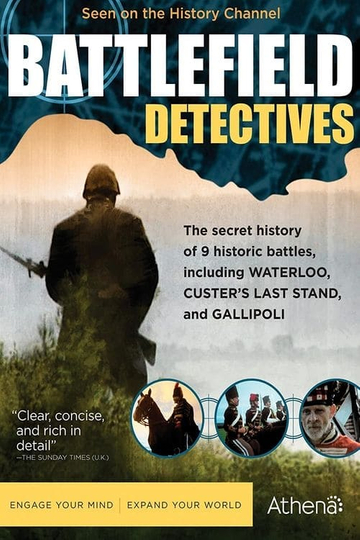Season 1 Episodes
1. Custer's Last Stand
The story of Custer's last stand is legendary. The Seventh Cavalry fought heroically against a horde of Indian warriors. The scale of the defeat, and its many unanswered questions has created a myth that's been told and retold in books and films. Now archaeologists, using the forensic skills of a crime scene investigation, begin to reveal what actually occurred at the battle of Little Big Horn.
2. Charge of the Light Brigade
Researchers use satellite technology and archaelological finds to unearth the truth about what happened at Balaklava during the most celebrated battle of the Crimean War. How disastrous was the British cavalry charge - and who were teh actual heroes in the defense of Balaklava?
3. The Gallipoli Disaster
Historians show how bad maps and worse intelligence produced the catastrophe of Gallipoli in 1915, and geologists reveal how terrain won the battle for the Turks and lost it for the Allies. Modern experts conclude that no amount of leadership, planning, or luck could have saved this doomed military venture.
4. What Sank The Armada?
The sinking of the Spanish Armada in the summer of 1588 has been attributed to English heroism, Spanish incompetence, and bad weather. Now archaeologists are working with oceanographers, meteorologists, and ship design experts to uncover the real reasons.
5. Who Got Luck at Hastings?
The sleuths set out to establish whether William the Conqueror's victory over King Harold at Hastings was really due to his leadership and the Normans' modern methods of fighting.
6. Massacre at Waterloo
In episode 6, Battlefield Detectives: Massacre at Waterloo asks - was there more to Napoleon's defeat than the tactics and fighting prowess of the Allies? Waterloo has always been seen as a tactical victory for the Duke of Wellington, his small but highly trained Allied army outfighting the veteran soldiers of Napoleon's Grand Army. Now the latest scientific techniques are shedding crucial light on Napoleon's campaign. And a dramatic archaeological discovery is helping answer the central question: what went wrong for Napoleon at Waterloo? The program uncovers why, for the first and only time in their history, Napoleon's Imperial Guard broke and fled from the battlefield.
7. Agincourt's Dark Secrets
Medieval warfare specialists investigate how terrain affected the way the 15th-century Battle of Agincourt was waged, what the rare battlefield artifacts tell us, and just what happens when an English bodkin point meets French armor.
8. Trafalgar
New research shows that Britain's most famous naval triumph, th 1805 Battle of Trafalgar, was anything but inevitable. Far from executing a carefully developed plan, Nelson sailed straight at the enemy broadsides based on little more planning than a recently discovered "back of the envelope" tactical sketch.
9. Vietnam's Bloody Secret
Veterans from both sides explain how state-of-the-art weaponry and a huge budget failed to overcome the morale and inventiveness of teh communist forces. Experts show how America never really understood who it was fighting, what motivated its enemies, or what methods they used.
10. Native American Wars: The Apache
11. American Revolution: Battle of Monmouth
The Battle of Monmouth took place on 28th June, 1778 in rural New Jersey. It was a key moment in the Revolutionary War between Great Britain and her thirteen rebellious colonies, and was the last major battle of the Revolution in the North. As the British Army's column led by Sir Henry Clinton left Monmouth Court House, the American Continental Army under George Washington attacked them at the rear. The battle became a standoff, with neither side able to inflict a crushing blow. Despite the lack of a decisive victory, for over 200 years this battle has been seen as one of George Washington's greatest triumphs, but now forensic science is casting a shadow of doubt over the battle-field. Was it such a triumph of personal command for Washington or was the first president just plain lucky?
12. World War One: The Somme
13. The Mexican-American War: Battle of Palo Alto
14. American Revolution: Battle of Cowpens
15. The Civil War: Gettysburg
16. The Civil War: Antietam
17. Battle of the Bulge
Just days before Christmas 1944, a quarter of a million German troops launched a shattering offensive through the Ardennes. Allied troops were taken completely off guard. They thought the war was almost over; only to find themselves engulfed in one of the greatest land battles of the 20th Century. At first, Hitler's Ardennes Offensive was successful, but nearly two months of fighting left the German Army in ruins. In this programme scientists and historians investigate why the Battle of the Bulge ended in total defeat for Germany.
18. Battle of Britain
For four long months during the summer of 1940, the RAF and the German Luftwaffe fought an epic battle in the blue skies and over the green fields of south east England. The Battle of Britain was the first major battle to be fought entirely in the air. It was the largest and most sustained bombing campaign yet attempted and the first real test of the strategic bombing theories that had emerged since the First World War. For more than sixty years the story of the Battle of Britain has been the story of an unprepared nation winning against overwhelming odds, a tale of heroism, of a handful of plucky pilots and of the battle winning Spitfire aircraft. Scientists, historians and veterans reveal that in fact Britain was far from unprepared. What were the secret systems and tactics which forced the Germans to withdraw from battle and led them to postpone and then cancel, their plans for invasion?
19. American Revoluton: Oriskany
20. Siege of Masada
Two thousands years ago, Jewish freedom fighters defied the Roman legions at Masada for three years, choosing death over slavery. Or did they? We join a team of experts as they use the latest scientific tools to piece together a new, and infinitely more controversial, version of the siege of Masada. Our scientists and archaeologists pose questions that have remained unasked for centuries. They ask how the Jewish defenders were able to hold out against such odds, also questioning how the Romans managed to conduct a siege in such a hostile environment.
21. World War One: Jutland
The Battle of Jutland between Britain and Germany was the largest naval action of all time. It was a confrontation that the British wanted. An opportunity to unleash their lethal super weapons of the day – the great ships they called Dreadnoughts – and to prove that Britain still ruled the waves. Yet, in the cold grey waters of northern Europe, the showdown ended in carnage on a scale few could have imagined. Today the ships with their vast gun turrets and thousands of shells still litter the sea bed. Nine thousand lives were lost, the majority British. Thousands were blown apart in three catastrophic explosions. Now, using the latest modern science, Battlefield Detectives investigates and asks: what went wrong? Why was Jutland so disastrous for the Royal Navy? And could it be that, in losing the battle, they won the naval war?
22. The War of 1812: The Chesapeake and the Shannon
23. Pointe du Hoc
Dawn on the 6th June, 1944. The largest invasion in history is underway. Four miles to the west of the Allied landings at Omaha Beach, a flotilla of landing craft head towards Hitler’s ‘Atlantic Wall’ defences. The landing craft were carrying just 200 men, of a newly trained elite force - the United States Rangers. Their objective was the vital German coastal defence gun battery on the headland known as the Pointe du Hoc. Climbing the ninety foot cliffs under a storm of German bullets and grenades, the Rangers found that the German guns were not where they should be. What followed was a desperate game of cat and mouse, as the Rangers attempted to hunt down the guns. The story of their mission is remembered now as one of the most extraordinary aspects of the D-Day landings. How did the heavily outnumbered US Rangers take, hold and destroy the guns of Pointe du Hoc?
24. The Civil War: Shiloh
Before dawn on Sunday April 6th 1862, shots rang out near Shiloh, on the west bank of the Tennessee River. A Confederate army had launched a surprise attack on their unsuspecting Union enemy. The Confederates had chosen the battlefield. They had chosen the moment to attack. And they achieved almost total strategic and tactical surprise. Twelve hours later they seemed to be in a commanding position – but on the next day they withdrew in disarray. For nearly 150 years Confederate failure has been blamed on the fact that they lost valuable time at a place called the Hornet’s nest – where a detachment of Union soldiers held the line. But now forensic history is uncovering a very different story of why things went so badly wrong for the Confederates at the Battle of Shiloh.
25. Siege of Alesia
26. The Six Day War
In 1967 the tension in the Middle East had neared boiling point. Border incidents between Israel and Syria, Egypt, and Jordan had increased massively during the early 1960s, with Palestinian guerrilla groups actively supported by Syria. Fighting on three fronts, against the combined might of five different armies, Israel secured a stunning victory in a mere six days. So how did this tiny state manage to overcome an Arab enemy which had twice as many soldiers, three times as many tanks and four times as many airplanes? Field testing of key Israeli weapons and analysis of battlefield strategy on both sides shows how this extraordinary victory was achieved.
27. Big Hole
28. Stalingrad
Far from being the final step in the conquest of the USSR, Stalingrad proved a bloodbath. Half a million Germans were killed and almost three times as many Russians lost their lives. Total casualties are estimated to be over two million. The German Army was modern, well-trained and well-led, with state of the art military equipment, high morale and a string of victories behind it. By comparison the Red Army was inexperienced, old-fashioned and ill-equipped. So how did the Russians win? Legend has it that it was ‘General Winter’ who defeated the German Army - but forensic analysis and historical research show that coping with freezing weather was not the only ace in the Russians’ packs.
















































